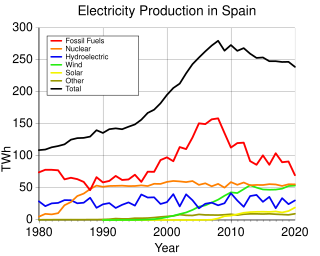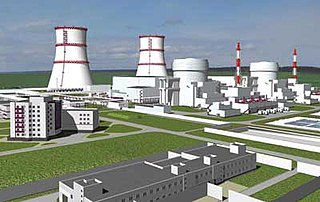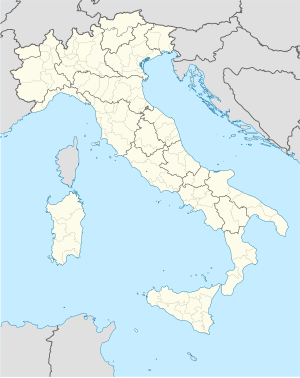The Agenzia nazionale per le nuove tecnologie, l'energia e lo sviluppo economico sostenibile is an Italian Government-sponsored research and development agency. The agency undertakes research in areas which will help to develop and enhance Italian competitiveness and employment, while protecting the environment. ENEA is an acronym that stands for Energia Nucleare ed Energie Alternative.

The EPR is a Generation III+ pressurised water reactor design. It has been designed and developed mainly by Framatome and Électricité de France (EDF) in France, and by Siemens in Germany. In Europe this reactor design was called European Pressurised Reactor, and the internationalised name was Evolutionary Power Reactor, but is now simply named EPR.

A nuclear power phase-out is the discontinuation of usage of nuclear power for energy production. Often initiated because of concerns about nuclear power, phase-outs usually include shutting down nuclear power plants and looking towards fossil fuels and renewable energy. Three nuclear accidents have influenced the discontinuation of nuclear power: the 1979 Three Mile Island partial nuclear meltdown in the United States, the 1986 Chernobyl disaster in the USSR, and the 2011 Fukushima nuclear disaster in Japan.

Nuclear energy policy is a national and international policy concerning some or all aspects of nuclear energy and the nuclear fuel cycle, such as uranium mining, ore concentration, conversion, enrichment for nuclear fuel, generating electricity by nuclear power, storing and reprocessing spent nuclear fuel, and disposal of radioactive waste. Nuclear energy policies often include the regulation of energy use and standards relating to the nuclear fuel cycle. Other measures include efficiency standards, safety regulations, emission standards, fiscal policies, and legislation on energy trading, transport of nuclear waste and contaminated materials, and their storage. Governments might subsidize nuclear energy and arrange international treaties and trade agreements about the import and export of nuclear technology, electricity, nuclear waste, and uranium.

The Nuclear Power Plant in Cernavodă is the only nuclear power plant in Romania. It produces around 20% of the country's electricity. It uses CANDU reactor technology from AECL, using heavy water produced at Drobeta-Turnu Severin as its neutron moderator and as its coolant agent. The Danube water is not used for cooling of the active zone.

Enel S.p.A. is an Italian multinational manufacturer and distributor of electricity and gas. Enel, which originally stood for Ente nazionale per l'energia elettrica, was first established as a public body at the end of 1962, and then transformed into a limited company in 1992. In 1999, following the liberalisation of the electricity market in Italy, Enel was privatised. The Italian state, through the Ministry of Economy and Finance, is the main shareholder, with 23.6% of the share capital as of 1 April 2016.
Nuclear decommissioning is the process leading to the irreversible complete or partial closure of a nuclear facility, usually a nuclear reactor, with the ultimate aim at termination of the operating licence. The process usually runs according to a decommissioning plan, including the whole or partial dismantling and decontamination of the facility, ideally resulting in restoration of the environment up to greenfield status. The decommissioning plan is fulfilled when the approved end state of the facility has been reached.

The Montalto di Castro nuclear power station was a nuclear power plant at Montalto di Castro in Italy. Consisting of two BWR units each of 982 MWe, it was approaching completion in 1988 when the Italian government decided to close all nuclear plants as a result of the 1987 referendum. In February 1988 the two units were eighty percent complete, representing about a five billion dollars investment. It never operated.

Caorso Nuclear Power Plant was a nuclear power plant at Caorso in Italy. It featured a single Boiling Water Reactor, a BWR 4 with a Mark II-Containment from General Electric, with an electrical net output of 860 MW, used low-enriched uranium as fuel, was moderated and cooled by normal light water.
Five nationwide popular referendums were held in Italy on 8 November 1987, with three questions about nuclear energy after the Chernobyl disaster, and two questions about justice. Voting day had been postponed by six months, according to the Italian Constitution, because of the snap election of spring.

Spain has five active nuclear power plants with seven reactors producing 20% of the country's electricity as of 2023.
Nuclear power in Romania provides around 20% of its electricity, with two nuclear reactors commencing operations in 1996 and 2007. In 2020, Romania generated a total of 56.1 TWh of electricity. The generation mix was composed of hydro (28%), nuclear (20%), natural gas (15%), coal (17%), wind (12%), solar (3%), and biofuels & waste. The Romanian government strongly supports nuclear energy.

The Kaliningrad Nuclear Power Plant (also referred as Baltic Nuclear Power Plant (NPP) or Baltiiskaya NPP, Russian: Калининградская атомная электростанция; Калининградская АЭС [] or Балтийская АЭС []) is a nuclear power plant under construction 13 kilometres (8.1 mi) south-east of Neman, in Kaliningrad Oblast, Russia. It is seen as a counter-project to the (later scrapped) plan to build the Visaginas nuclear power plant in Lithuania and is considered not only as an energy, but also as a geopolitical project. Originally intending to commission the reactors in 2016 and 2018, construction was temporarily stopped in June 2013 for the project to be redesigned for lower power output after neighbouring countries showed no interest in importing its electricity. However, the downgrade was later discarded. No export partners materialised as of 2021 and the project remains in stand-by.

Chicco Testa is an Italian politician. He graduated in philosophy at the Università Statale in Milan (1976). He lives in Rome and has two sons.

Energy in Italy comes mostly from fossil fuels. Among the most used resources are petroleum, natural gas, coal and renewables. Italy has few energy resources, and most supplies are imported.
National nuclear energy policy is a national policy concerning some or all aspects of nuclear energy, such as mining for nuclear fuel, extraction and processing of nuclear fuel from the ore, generating electricity by nuclear power, enriching and storing spent nuclear fuel and nuclear fuel reprocessing. Nuclear energy policies often include the regulation of energy use and standards relating to the nuclear fuel cycle.
Slovakia has five operational nuclear reactors, with a combined net power capacity of 2,308 MWe, with a sixth coming on line shortly.
Italy's total electricity consumption was 302.75 terawatt-hour (TWh) in 2020, of which 270.55 TWh (89.3%) was produced domestically and the remaining 10.7% was imported.

SOGIN is an Italian state-owned enterprise responsible for nuclear decommissioning as well as management and disposal of radioactive waste produced by industrial, research and medical processes. Founded in 1999 following the 1987 Italian referendums on nuclear power, SOGIN was originally part of state owned ENEL but became independent, but still government owned, in 2000. The company initially took over the Caorso, Enrico Fermi, Garigliano and Latina nuclear power plants, later adding other sites including ENEA's EUREX. The company has commenced the decommissioning of all the plants and is predicted to complete the work in 2036. The company has been involved in environmental remediation, radioactive waste management and nuclear safety work in Armenia, Bulgaria, China, Czech Republic, France, Kazakhstan, Lithuania, Romania, Russia, Slovakia and the Ukraine. SOGIN also undertakes other decontamination work and in 2005 started to help to decommission nuclear submarines of the Russian Navy.
CIRENE is an Italian nuclear reactor design and the name of the prototype model that was built at the Latina Nuclear Power Plant south of Rome. CIRENE, an acronym for CISE Reattore a Nebbia, uses heavy water as its neutron moderator and normal "light" boiling water as the coolant. This reduces the amount of heavy water required for operations compared to CANDU, still using natural uranium as fuel. CIRENE was one of several similar heavy/light water designs, with similar small-scale units at Gentilly in Canada, SGHWR in the United Kingdom and Fugen in Japan.













